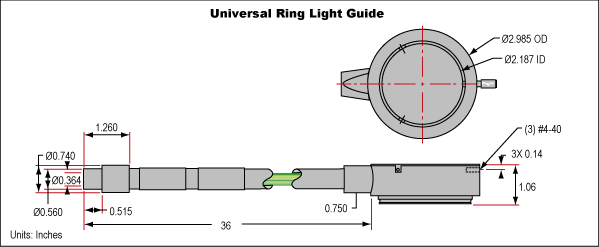
| Inner Diameter (inches) | Compare | Stock Number | Price | Buy | |
|---|---|---|---|---|---|
| 2.370 | #58-839 | ₹94,050 Request Quote |
|
||
| 1.550 | #54-174 | ₹63,000 Request Quote |
|
Light guide adapters needed to mate with fiber optic illuminators.

| C'Bore Diameter A | Inner Diameter B | Outer Diameter C | C'Bore Depth D | Ring Height E | Bundle Diameter F | Ferrule Diameter G | Stock No. |
| 0.830" | 0.830" | 1.630" | N/A | 0.735" | 0.250" | 0.312" | #54-176 |
| 1.125" | 1.125" | 1.875" | N/A | 0.800" | 0.250" | 0.312" | #54-175 |
| 1.550" | 1.550" | 2.562" | N/A | 1.150" | 0.333" | 0.562" | #54-174 |
| 2.370" | 2.000" | 3.475" | 0.760" | 1.200" | 0.365" | 0.562" | #54-173 |
| 2.600" | 2.370" | 3.480" | 0.800" | 1.000" | 0.365" | 0.562" | #58-839 |
| 3.790" | 3.500" | 5.000" | 0.760" | 1.370" | 0.462" | 0.562" | #54-258 |
  |
|||||||
1-800-363-1992
or view regional numbers
QUOTE TOOL
enter stock numbers to begin
Copyright 2025, Edmund Optics India Private Limited, #267, Greystone Building, Second Floor, 6th Cross Rd, Binnamangala, Stage 1, Indiranagar, Bengaluru, Karnataka, India 560038
California Consumer Privacy Acts (CCPA): Do Not Sell or Share My Personal Information
California Transparency in Supply Chains Act